Agriculture
has always been the major local occupation, although the number of
people engaged in it has steadily declined. Prior to the mid 17th century Tixall was farmed on an
open field system, with Near, Middle and Far fields, divided up between
the various tenants. Records of farm tenancies start with some 17th
century wills for (Upper) Hanyards.
In 1766 a detailed
survey of the estate was carried out which shows many small farms with
fields scattered throughout Tixall. Only (Lower)
Brancote occupied
by James Clegg, and to a lesser extent, Upper Hanyards, occupied by John
Hathersich/Heddersich, were compact farms.
Thomas Clifford set about
re-organising the estate, and by 1833 five main farms had been
established:
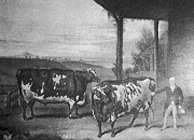
In May 1827, when Sir
Thomas Aston Clifford Constable came of age, these two Durham Oxen from Brancote were slaughtered for the celebrations,
weighing 2478 and 2437 lbs respectively.
When Earl Talbot bought the
estate in 1845, his son, Viscount Ingestre entered a partnership with
Thomas Hartshorne to rebuild Brancote as a model farm on its present
site. All the farms except Upper Hanyards had new tenants:-
In the 1851 census
there had been few changes, only William Bowers had been replaced at Lower Hanyards in 1848 by Joseph Ford. In 1861
F.Nash had
replaced Thomas Hartshorne at Brancote, and
W.H.Steward had occupied Tixall Heath since 1860. This pattern of
continuity at Tixall Farm and the Hanyards continues. In 1871, William
Power had occupied Brancote and Thomas Bottley Tixall Heath,
both since 1867. W.H.Avery replaced Bottley from 1870 to 1874, and
W.T.Mynors,
Talbot's agent, took over Tixall Farm in 1876. In 1877
Henry Dodd arrived at Tixall Heath Farm.
The relative size of the farms
in the 19th century and the decline in the number of people engaged in
farming, can be seen from the Census Returns. The Dog
Kennels was used to house agricultural labourers, as was Old Hill
Barn, these served the other large farms on the estate, or smaller
homesteads based in the
village such as at Tixall Villa:-
Anson Primary school have
some
interesting information about current farming in the Tixall area.
TIXALL FARM :-
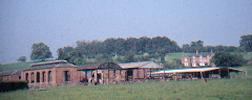 The buildings probably
date from the late 18th century when Thomas Clifford reorganised the
Tixall
Estate. They are red brick, with ashlar and brick dressings and slate
hipped
roofs. They are build on a quadrangle with a two storey, 17 bay building fronting the road,
with a slightly projecting 3 bay centre. The central segmental carriage
arch has a 3-light casement above, and a square tower containing a
pigeoncote with corner turrets with pyrimidal caps.The tower has an
ashlar plaque with a coat
of arms, and a round headed recessed panel above with flight perches
and
openings. The tower is topped by a slate roof an an ornate wooden
cupola with
weather vane.
The buildings probably
date from the late 18th century when Thomas Clifford reorganised the
Tixall
Estate. They are red brick, with ashlar and brick dressings and slate
hipped
roofs. They are build on a quadrangle with a two storey, 17 bay building fronting the road,
with a slightly projecting 3 bay centre. The central segmental carriage
arch has a 3-light casement above, and a square tower containing a
pigeoncote with corner turrets with pyrimidal caps.The tower has an
ashlar plaque with a coat
of arms, and a round headed recessed panel above with flight perches
and
openings. The tower is topped by a slate roof an an ornate wooden
cupola with
weather vane.
The roadside barn has 5 large segmental arches on
each side, and single arches at the ends.There is a slate roof and
a continuous ventilator.

The central archway leads to
an enclosed yard surrounded by barns and other single storey buildings,
leading through a further archway up the hill to the farmhouse
behind.
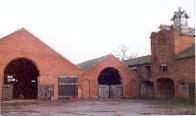 The yard used to contain additional
buildings including 3 large cowsheds with round headed arched
entrances. The
adjacent large brick threshing barn was partially rebuilt when the farm
was
converted for residential use. To the north, the stable range has a two
storey
7 bay centre, with a central arch flanked by stables with lofts above.
Either
side are single storey wings, on the left were 6 implement sheds and on
the
right further stables. It is now fully converted to residential use. The yard used to contain additional
buildings including 3 large cowsheds with round headed arched
entrances. The
adjacent large brick threshing barn was partially rebuilt when the farm
was
converted for residential use. To the north, the stable range has a two
storey
7 bay centre, with a central arch flanked by stables with lofts above.
Either
side are single storey wings, on the left were 6 implement sheds and on
the
right further stables. It is now fully converted to residential use.
In
the late 19th century and early 20th century, Tixall Farm was
predominantly pasture and meadow, with little arable, unlike the other
four farms on the Tixall Estate.
KENNELS FARM:-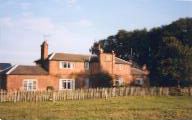
This is a relatively
new farm,
formed in the 1940s from the old Dog Kennels.
BRANCOTE
FARM:-
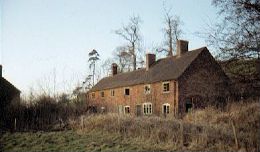 The original Lower Brancote Farm probably dates from Domesday and
was by the river as
shown in the 1833 map. The present farm
was built as a model farm by Viscount Ingestre and Thomas Hartshorne
around 1850. Hartshorne removed all straggling fences and laid his
arable farm into four fields of about 100 acres each.
The original Lower Brancote Farm probably dates from Domesday and
was by the river as
shown in the 1833 map. The present farm
was built as a model farm by Viscount Ingestre and Thomas Hartshorne
around 1850. Hartshorne removed all straggling fences and laid his
arable farm into four fields of about 100 acres each.
The land had been
drained as necessary and was good for turnips and barley. A four course
system was used, applying all dung from the farm to the seeds, except
that needed for his mangold wurzel. Artificial manures were used for
his turnips.
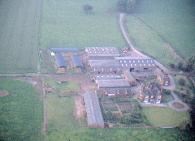
The extensive new buildings
included feeding houses, with a railway in front for wheeling food, a
steam engine for threshing, etc. and extensive yards for feeding swine.
In 1850 a tank was being constructed to collect the liquid manure,
which was to be used
on an adjacent field newly sown with grass, as each cutting was removed
for consumption to the farm buildings.
Two hundred pigs were kept,
which were cheaply fed on roots in winter and clover in summer. They
were driven out each morning, and folded on clover like sheep,
returning in the afternoon to the farm yard, where they remained at
night well littered with straw.
Since 1932 it has been farmed by the
Parrott family. There is more
information about Brancote on the Anson School site.
TIXALL HEATH
FARM:-
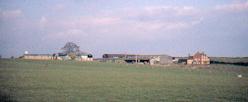 This was a new farm created by Thomas
Clifford on the site of an old barn, following enclosure of more of
Tixall Heath in the 1740s. This was a new farm created by Thomas
Clifford on the site of an old barn, following enclosure of more of
Tixall Heath in the 1740s.
In the winter
before1869 Mr T.D.Botteley had cut up 70 to 80 tons of straw, with 25
tons of hay, and mixed this with boiled corn and oatcake to fatten 40
beasts and 200 sheep, besides wintering 50 store oxen and 300 sheep
using 7 acres of mangold,
16 acres of middling swedes and a few stubble turnips.
The buildings were mainly of
brick, with few covered yards "which are undesirable in the rearing of
cattle
for sanitary reasons" - "direct sunlight as well as pure air are
necessary
for young animals."
When Samuel Dodd retired in
1923 the sale included 81 cattle and 13 horses - he had been a member
of the
Shire Horse society for 25 years. The farm was occupied by R.McCulloch
from
1929 to 1932, and by J.Fairbanks from 1933 until it was bought by the
Colliers in 1967.
ST THOMAS PRIORY FARM:-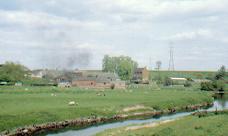
This farm only became
part of
Tixall in the 1980s, previously it was part of Hopton with Coton. There
were
two farms on the site, the main farm based on the old Priory buildings
and
another smaller farm based on St Thomas's Mill.
UPPER HANYARDS
FARM:-
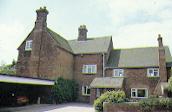 There has probably been a farm at Upper
Hanyards since Domesday. There has probably been a farm at Upper
Hanyards since Domesday.
In 1675 there were 2
chambers upstairs, 2 rooms downstairs and a cellar.The stock consisted
of 5 cows,
a bull and some young cattle and calves; some sheep; 3 mares a cart
with
hay; corn in the barn and house, threshed and stacked, and growing; and
2
swine.
By 1727 there were 12
milking cows, a bull, 4 winter heifers, 7 stirks, and 6 rearing calves;
2 mares, 2
yearling colts, a yearling filly, and a mare; and 2 store pigs.Crops
included wheat, peas and beans,and oats. The Johnson family occupied
the farm from 1898 until 1939 when it was taken over by J.S.Madders,
who subsequently bought both Upper and Lower Hanyards in 1967. The two farms are shown on
the 1833 estate map, alongwith Tixall Heath Farm.
LOWER HANYARDS
FARM:-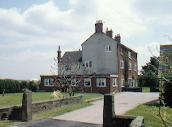
This was a new farm
created by
Thomas Clifford on the site of an old barn. Like Upper Hanyards, it was
separated from the rest of Tixall by the Deer Park. Alongwith Upper Hanyards it is still farmed by the Madders
family.
|

 The buildings probably
date from the late 18th century when Thomas Clifford reorganised the
Tixall
Estate. They are red brick, with ashlar and brick dressings and slate
hipped
roofs. They are build on a quadrangle with a two storey,
The buildings probably
date from the late 18th century when Thomas Clifford reorganised the
Tixall
Estate. They are red brick, with ashlar and brick dressings and slate
hipped
roofs. They are build on a quadrangle with a two storey, 
 The yard used to contain additional
buildings including 3 large cowsheds with round headed arched
entrances. The
adjacent large brick threshing barn was partially rebuilt when the farm
was
converted for residential use. To the north, the stable range has a two
storey
7 bay centre, with a central arch flanked by stables with lofts above.
Either
side are single storey wings, on the left were 6 implement sheds and on
the
right further stables. It is now fully converted to residential use.
The yard used to contain additional
buildings including 3 large cowsheds with round headed arched
entrances. The
adjacent large brick threshing barn was partially rebuilt when the farm
was
converted for residential use. To the north, the stable range has a two
storey
7 bay centre, with a central arch flanked by stables with lofts above.
Either
side are single storey wings, on the left were 6 implement sheds and on
the
right further stables. It is now fully converted to residential use.

 The original Lower Brancote Farm probably dates from Domesday and
was
The original Lower Brancote Farm probably dates from Domesday and
was 
 This was a new farm created by Thomas
Clifford on the site of an old barn, following enclosure of more of
Tixall Heath in the 1740s.
This was a new farm created by Thomas
Clifford on the site of an old barn, following enclosure of more of
Tixall Heath in the 1740s. 
 There has probably been a farm at Upper
Hanyards since Domesday.
There has probably been a farm at Upper
Hanyards since Domesday. 